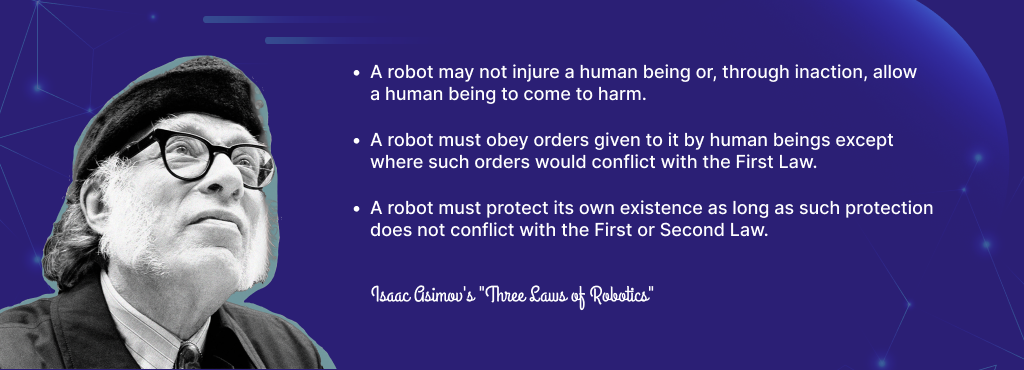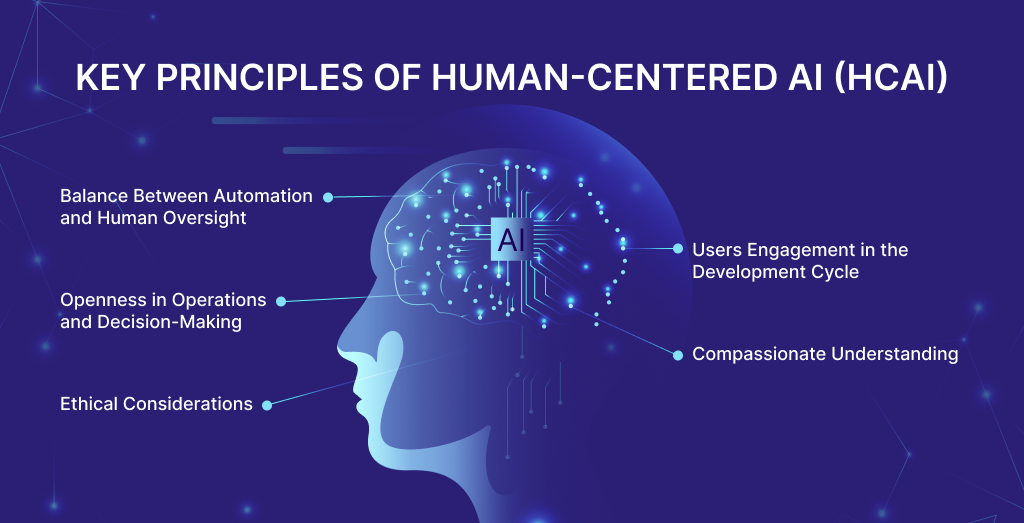Summary
Human-Centered AI (HCAI) prioritizes human welfare and values in AI development, aiming to create systems that enhance human capabilities while respecting autonomy.
Key principles of HCAI include compassionate understanding, where AI systems are designed to be empathetic and responsive to users’ needs and contexts.
This approach emphasizes the symbiotic relationship between humans and AI, ensuring technology serves as a partner that augments human decision-making and well-being.
In an age where artificial intelligence is rapidly reshaping the landscape of our daily lives, the concept of Human-Centered AI (HCAI) emerges as a beacon of hope for a future where technology harmonizes with human needs and aspirations. Artificial intelligence is changing along with other technologies, and there are already solutions that help us, humans, to use technologies more efficiently with the help of AI.
By placing humans at the heart of AI development, we embark on a journey towards creating intelligent systems that not only understand and enhance our capabilities but also respect the values and ethics that define us as a society. Therefore, let’s delve into the essence of HCAI and unravel its potential to revolutionize the way we interact with AI systems.
What Is Human-Centered AI?
Human-Centered AI (HCAI) represents a paradigm shift in the development and deployment of artificial intelligence technologies. At its core, HCAI is about designing AI systems that prioritize human welfare, augment human capabilities, and embody human values. This approach ensures that AI technologies are developed with a deep understanding of human contexts, needs, and ethical considerations.
HCAI emphasizes the symbiotic relationship between humans and AI, where technology is not just a tool that replaces humans but a partner that respects human autonomy and decision-making. It is about creating intelligent systems that work alongside humans to enhance their lives, prioritizing human needs, values, and capabilities, rather than about creating autonomous systems that operate independently of humans.

What Are the Key Principles of HCAI?
The key principles of Human-Centered AI (HCAI) are designed to ensure that AI systems prioritize humans, which is why they should consider:

Compassionate Understanding
AI should be developed with a deep understanding of the user’s needs and contexts in order to be able to offer suitable and personalized solutions. It means that the AI systems should be designed to be empathetic and responsive to the specific situations, preferences, and requirements of the users. Here’s what it involves:
- Personalization. AI should provide tailored experiences that adapt to individual user preferences, habits, and past interactions.
- Context-Awareness. HCAI software systems must be aware of the user’s environment and circumstances to offer relevant and timely solutions.
- User Experience (UX) Design. The UX/UI design of AI interfaces should be intuitive and user-friendly, ensuring ease of use for people with varying levels of technical expertise and abilities.
- Cultural Sensitivity. Artificial intelligence should respect and adapt to different cultural norms and practices, providing appropriate responses and services.
- Empathy. AI should be able to interpret and respond to human emotions appropriately, enhancing the user’s experience and satisfaction.
By focusing on these aspects, AI can offer solutions that are not only technically sound but also genuinely useful and satisfying for the user, thereby creating a more human-centric interaction.
Ethical Considerations
AI must be designed to address ethical concerns and actively work to mitigate biases. It means that Artificial Intelligence software solutions should be developed with a focus on fairness, accountability, transparency, and bias mitigation.
- Fairness. HCAI systems should treat all users equitably and not perpetuate or amplify existing social inequalities. This involves designing algorithms that do not discriminate based on race, gender, age, or other personal characteristics.
- Accountability. Developers and operators of AI systems should be responsible for the outcomes of their systems. It means that there should be clear policies and procedures for addressing any issues or harms that may arise.
- Transparency. Human-centered AI systems should be understandable by humans, with clear explanations of how decisions are made. This is crucial for building trust and allowing users to appeal or challenge decisions that affect them.
- Bias Mitigation. Since HCAI solutions learn from data, they can inadvertently learn and replicate biases present in that data. Actively working to mitigate biases involves using diverse datasets, regularly testing for biases, and adjusting algorithms to reduce discriminatory outcomes.
In essence, addressing ethical concerns and mitigating biases in AI means creating systems that are just and fair, that can be held accountable for their actions, and that operate transparently and without prejudice. It is about ensuring that AI serves the good of all, without causing harm or injustice to any individual or group.
Users Engagement in the Development Cycle
Active user involvement in the development process of AI systems means engaging with the end-users throughout the creation and implementation stages to ensure that the technology meets their needs and aligns with ethical standards. Here’s what it entails:
- Co-Design. Users participate in the design process, contributing ideas and feedback that shape the development of the HCAI system.
- User Testing. Potential users are involved in testing AI solutions to identify any issues, usability challenges, or areas for improvement.
- Feedback Loops. Establishing channels for continuous user feedback to refine and enhance the HCAI application over time.
- Ethical Oversight. Users can provide insights into the ethical implications of the AI system in real-world scenarios, helping to identify and address potential concerns.
By involving users actively, developers can create software systems that are not only technically proficient but also socially responsible, user-friendly, and ethically sound. This collaborative approach leads to more effective and trustworthy AI solutions.
Read Also Using Human-Centered Design to Create Better Products (ex. Migraine Tracking App)
Openness in Operations and Decision-Making
When we say that AI should operate transparently and be explainable, it means that the HCAI systems should be designed in a way that their processes and decisions can be understood by humans. This is crucial for building trust and acceptance among users.
- Transparency. The inner workings of HCAI systems, such as the data used, the algorithms applied, and the decision-making processes, should be open to inspection. Users should have access to information about how the system operates.
- Explainability. AI should be able to provide understandable explanations for their decisions and actions. For example, if an HCAI software makes a recommendation or decision, it should be able to explain the reasoning behind it in terms that users can comprehend.
- User Trust. When users understand how an AI system works and why it makes certain decisions, they are more likely to trust it. Trust is essential for the adoption and proper use of AI technologies.
- Regulatory Compliance. Many regions have regulations that require AI to be transparent and explainable. This is to ensure that AI systems are fair, non-discriminatory, and accountable.
Transparent and explainable AI helps ensure that technology serves the public interest, respects user autonomy, and fosters an environment where artificial intelligence aids rather than obscures human decision-making. Thus, they are able to become the tools that humans can understand and control.
Balance Between Automation and Human Oversight
Artificial intelligence should amplify and augment human abilities, preserving human control where necessary. The balance between automation and human control in HCAI systems refers to the careful calibration of AI’s autonomous functions with the need for human oversight and decision-making. Here’s what it means:
- Autonomy. Human-centered AI systems can perform tasks without human intervention, which increases efficiency and reduces the burden on humans.
- Human Oversight. Despite the autonomy, there should always be a mechanism for human beings to oversee, intervene, and correct the AI system’s actions if necessary.
- Collaborative Interaction. AI should complement human skills and work in tandem with humans, rather than replacing them entirely.
- Ethical Decision-Making. Certain decisions that have ethical implications or require nuanced understanding should remain under human control.
- Safety and Reliability. The balance ensures that HCAI systems operate safely and reliably, with humans able to take control in critical situations.
This balance is crucial for maintaining trust in HCAI solutions to ensure that they are used responsibly and effectively and are beneficial and respectful of human rights and privacy.
Read Also How Generative AI Chatbots Enhance Business Operations
Which Examples of HCAI Apps Can Be Found in Various Industries?
HCAI can be applied across a wide range of domains, from healthcare and education to transportation and entertainment. It can also be used in our everyday life. For example, let’s take a look at the voice-to-text search in our mobile devices, smart TVs, computers, etc. that some of us use daily.
Voice-to-text search is indeed an example of Human-Centered AI. It is designed to augment human capabilities by allowing users to perform searches using their voice, which is a natural form of communication for humans. This technology takes into account the user’s convenience and accessibility needs, making it easier for people to interact with devices and access information without the need for typing. By focusing on the user’s experience and needs, voice-to-text search embodies the principles of HCAI.

Or, take a look at your Alexa. Virtual assistants, like Alexa, Cortana, Siri, and others, are also designed with Human-Centered AI principles in mind. These AI assistants are created to enhance and augment human abilities, providing services that are tailored to user needs and preferences. They embody HCAI by understanding natural language, personalizing responses and services, offering hands-free assistance, and by following ethical design. These features align with the core values of HCAI, which focus on creating AI systems that are empathetic, ethical, inclusive, and transparent, ultimately aiming to serve and amplify human capabilities.
Besides these AI partners, there are even more examples in different business spheres. Human-Centered AI can be applied across a wide range of industries to enhance human abilities and ensure that AI systems are designed with human needs at the forefront.
Healthcare
HCAI is increasingly being utilized in the healthcare software systems to assist with diagnosis, improve patient treatment planning and outcomes, enhance the efficiency of care delivery, and support healthcare professionals.
- Treatment Personalization. HCAI can analyze patient data to suggest personalized treatment plans, taking into account individual genetic factors, lifestyle, and medical history.
- Robot-Assisted Surgery. Surgical robots, powered by AI, can assist surgeons in performing precise and minimally invasive procedures.
- Virtual Health Assistants. AI-powered virtual assistants can be used not only for Internet surfing or constantly telling Alexa to turn off, but they can also provide patients with health information, medication reminders, and support for routine health-related inquiries.
- Health Equity. AI has the potential to improve health outcomes for everyone, everywhere, by creating more personalized, accessible, and effective solutions, especially in resource-challenged communities.
Read Also These 7 Healthcare Systems Can Bring Your Business Luck and Prosperity
Education
Education software with Human-Centered AI is making significant strides in the education industry, transforming the way learning and teaching are approached, making the experience personalized and accessible. By integrating HCAI into the education system, the goal is to create more engaging, effective, and inclusive learning experiences for all students.
- Personalized Learning. AI systems can adapt to the learning pace and style of individual students, providing customized resources and support to enhance their learning experience.
- Intelligent Tutoring Systems. These systems offer one-on-one tutoring by giving immediate feedback, assessing student progress, and adjusting instruction accordingly.
- Collaborative Learning Environments. AI facilitates collaborative learning by connecting students and teachers from different locations, enabling group work and discussions.
- Curriculum Development. AI can analyze curriculum effectiveness and suggest improvements or new content based on student performance data.
Read Also Assistive Technology: Enhancing Lives and Promoting Inclusivity in Online Learning and Testing
Finance
HCAI is reshaping the finance industry by enhancing the capabilities of financial professionals and improving customer experiences. HCAI helps in personalizing financial advice, detecting fraudulent activities, and improving customer service in the banking sector.
- Automated Customer Service. AI chatbots and virtual assistants provide personalized customer support, handling inquiries and transactions efficiently.
- Fraud Detection. HCAI systems analyze patterns in transaction data to identify and prevent fraudulent activities, protecting both the institution and its customers.
- Personalized Financial Advice. Artificial intelligence can offer customized financial advice by understanding individual customer profiles and preferences.
- Credit Scoring. HCAI improves the accuracy of credit scoring by considering a broader range of factors, leading to fairer lending practices.
Manufacturing
By integrating HCAI into manufacturing, the industry can move towards more sustainable, efficient, and worker-friendly production processes. This approach contributes to smart factories, predictive maintenance, and collaborative robots that work alongside humans.
- Collaborative Robots (Cobots). Cobots work alongside humans on the factory floor, designed to interact safely and effectively with human workers.
- Worker Training. Human-centered AI provides personalized training programs, adapting to the learning pace and style of each worker.
- Safety Monitoring. AI monitors the work environment to identify potential safety hazards and reduce the risk of accidents.
- Customization. HCAI enables cost-effective customization of products by assisting in the design and manufacturing processes.
Conclusions
So, is HCAI better than AI? Is it as powerful as it seems? It all depends on the context and the goals you aim to achieve. Human centered AI is a subset of artificial intelligence that offers a vision of a world where technology and humanity converge in a symphony of collaborative progress. It is not about one being better than the other; rather, it’s about how AI is applied.
Embracing the human-centered artificial intelligence approach is not just about harnessing the potential of AI; it’s about shaping a future that reflects our collective human spirit, ensuring that as we advance technologically, we remain anchored in the principles that make us uniquely human. Therefore, if you need help in developing a human-centered application, contact us, and let’s create a better world together!